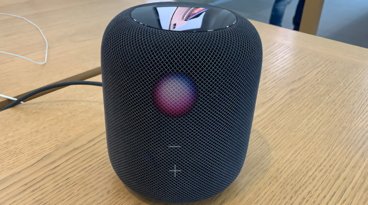Could NVIDIA chipsets replace those from Intel in next-gen Macs?
In a report earlier this week, AppleInsider noted that Apple appears to be forgoing Intel's Montevina chipset — not its Core 2 Duo processors — for an unknown alternative beginning with an upcoming generation of Macs.
Weighing that report alongside comments by Apple chief financial officer Peter Oppenheimer about an upcoming "product transition," as well as strategic plans on the part of NVIDIA, PC Perspective's Ryan Shrout concludes that there's "no doubt that come fall you will find updated MacBooks and MacBook Pros with NVIDIA chipsets and GPUs inside."
Shrout's analysis starts by evaluating Apple's options should it decide not to use Intel's supporting chipsets going forward. Currently, the company's 13-inch MacBooks obtain their graphics capabilities via the Intel GMA X3100 graphics processor built into Intel's Santa Rosa chipset. And while there's nothing stopping Apple from developing its own proprietary integrated graphics solution, assuming that task on its own would be daunting.
"This would take much longer, and require many more resources than I think Apple has in its engineering team," he writes. "Designing their own core logic and IGP (integrated graphics processor) chipset just isn’t in the equation at this point."
Apple's remaining option is to therefore reach out to a third party chipset manufacturer, for which there are only two suitors: ATI (which is now part of AMD) and NVIDIA. While AMD may seem like an ideal partner, Shrout argues that the company lacks a "top-shelf chipset" and has been spending the majority of its time on its Puma platform, which is built for use solely with its own breed of Turion mobile processors.
On the other hand, NVIDIA has been developing its own MCP79 family of chipsets that will work with Intel's latest mobile processors and compete directly with Montevina. The company has also been quite vocal on what it thinks of Intel's integrated graphics solutions. During an analyst conference earlier this year, chief executive Jen-Hsun Huang called out Intel on performance and promised that NVIDIA would "open a can of whoop ass" later this year.
Shrout believes the MCP79 is exactly where Apple may be headed. Each variant of the chipset incorporates a GeForce graphics core supporting Shader Model 4.0 visual effects, NVIDIA's VP3 video processor for accelerating movie playback, and support for power management techniques that include Hybrid Power, Hybrid SLI and Hybrid Performance. The MCP79 also sports an HDMI video output interface and supports features very similar to Intel's own Centrino 2 platform, such as support for a 1066 MHz front side bus, DDR2 or DDR3 memory, DriveCache (similar to Intel's Turbo Memory flash memory cache) and up to 20 PCI Express 2.0 lanes.
And unlike Intel's chipsets, which contain separate northbridge and southbridge chips, the MCP79 is actually just a single compact chip. It's also compatible with a new line of GeForce mobile GPUs introduced by NVIDIA this week.
Before NVIDIA suddenly went silent on its mobile plans earlier this year, the company said it was developing at least six distinct members of the MCP79, including a version with integrated graphics that could possibly be powerful enough for a MacBook Pro without the need for a discrete GPU, as well as an ultra-low voltage version that would be a sure candidate for the MacBook Air.
In his report, Shrout also made reference to NVIDIA's sudden secrecy.
"They have been surprisingly silent for quite some time; there have been no planned media summits or technology days on these well known mobility products," he wrote. Â "And that fits in with the traditional Apple mentality of keeping their partners silent as long as possible. Â If an OEM asks you to pull back on promoting a product you have had in development for this long, that OEM had better be as big a name as Apple."
A move towards NVIDIA chipsets would also address comparatively weak 3D gaming support for Apple's MacBook and iMac lines while playing into the company's longer term software strategy. One of the more publicized features of Mac OS X 10.6 Snow Leopard is support for the proposed OpenCL standard, which will allow next-generation Macs to pass off to the new wave of graphics chips some of the calculations once reserved only for the primary CPU.
 Slash Lane
Slash Lane













 Amber Neely
Amber Neely
 Thomas Sibilly
Thomas Sibilly
 AppleInsider Staff
AppleInsider Staff
 William Gallagher
William Gallagher
 Malcolm Owen
Malcolm Owen
 Christine McKee
Christine McKee









57 Comments
Why has Intel not purchased NVIDIA? If this is true, I bet Intel is loving Steve about now.
Why has Intel not purchased NVIDIA? If this is true, I bet Intel is loving Steve about now.
Wasn't there some speculation on intel.com that Jobs' cancer had returned? Maybe that was on msn.com where I saw it. Or was it on a verizonwireless.com blog? I'm sorry, I just don't remember--and my name isn't Scott Moritz!
Yay, OpenCL!!!
so AMD is dead and gone? ....
kinda sad, hope apple use AMD some ways, if they go with nVidia, we may not even see ATI hmmm
Makes sense to me...also lessens Apple's reliance on Intel for processor AND chipset, and allows them a little more secrecy again as to when they release updated hardware (only have to follow Intel's processor refreshes, not their chipset refreshes too)...not that these would be the primary reasons for them doing it.
@aplnub, I'm assuming that's sarcasm?
Why this rings as true...